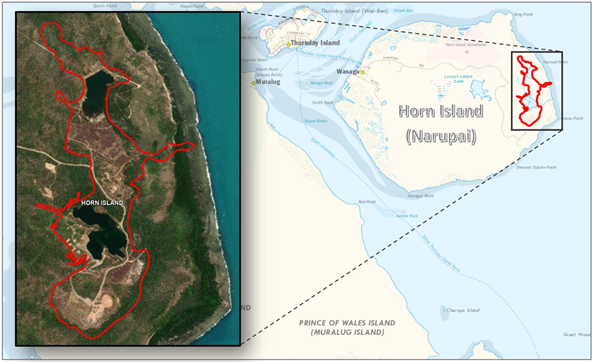Horn Island remediation project
Following discovery of gold on Horn Island in 1894, alluvial and hard rock mining was carried out until around 1920. In 1987, Torres Strait Gold Pty Ltd (subsidiary of Augold NL and Giant Resources) started open-pit mining, which continued until December 1989 when the mine was closed.
- View a glossary of mining terms used on this page.
We began managing and remediating the Horn Island mine in 1991. This remediation work helps prevent acid and metalliferous drainage from the abandoned mine entering the island’s fringing coral reef system.
An Indigenous Land Use Agreement between the Queensland Government, the Torres Shire Council and the Kaurareg People (the traditional owners of Horn Island) was established in October 2000, formalising the roles and obligations for each party over the site. Under the agreement, Lots 48 and 49 will become transferred land under the Aboriginal Land Act 1991 (the Act) as soon as practicable after their remediation.
The handover of Lot 48 on SP142707 was formalised by Deed of Grant under the Act in June 2013.
The Horn Island site consisted of an open pit, low-grade ore stockpiles, waste rock dumps, tailings storage facility, process water dam, sulphide ponds and processing plant area.
There are current exploration permits (mineral) over the site.
Project snapshot
Region: Torres Strait
Location: Part of the Torres Strait Islands group at the tip of Cape York Peninsula, Latitude: -10.603858, Longitude 142.315720
Commodity: Gold
Mining type: Open cut
Date of abandonment: August 1990
Status: Remediation ongoing with the potential for re-commercialisation
Native title interest: Kaurareg People represented by Kaurareg Native Title Aboriginal Corporation RNTBC
Public land registers: Listed on the Environmental Management Register
Photo gallery
Key risks
Health and safety risks associated with:
- unmaintained processing plant and equipment
- open pit, waste rock stockpile and historic shaft/mine entrance
- embankment stability of the process water dam.
Environmental risks associated with:
- exposed tailings held in the tailings storage facility and contaminated material held in the sulphide ponds
- poor-quality water as a result of acid and metalliferous drainage seepage from a number of remnant mining features such as pit, waste rock piles, tailings storage facility and process water dam
- groundwater contamination associated with acid and metalliferous drainage.
Completed works
Since taking over management of the mining-related issues on the island, we have commissioned approximately $7.5 million of remediation and monitoring works including those listed below.
- Removal of processing plant and equipment
- Encapsulation of the tailings and sulphide ponds
- Partial encapsulation of the waste rock stockpiles
- Implementation of growth medium to low-grade ore stockpile
- Installation of a solar pump-back system to return seepage to the process water dam
- Installation of 18 groundwater bores for ongoing groundwater quality monitoring
- Partial resolution of land tenure issues
- Development of options for the decommissioning of the process water dam
- Facilitation of industry partnership with the exploration lease holders
Planned works
- Continuing industry partnership with the exploration lease holders
- Continuing investigations to decommission process water dam



